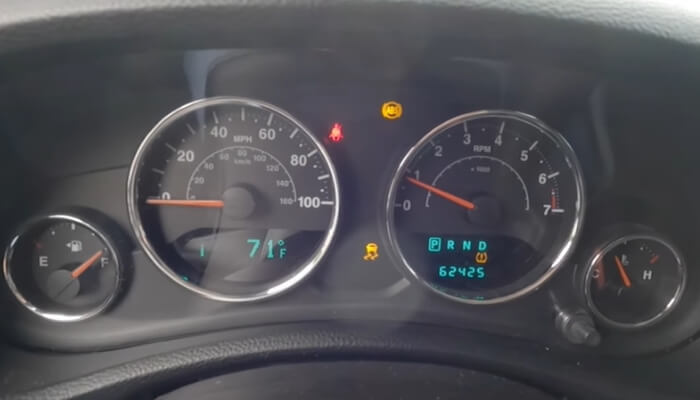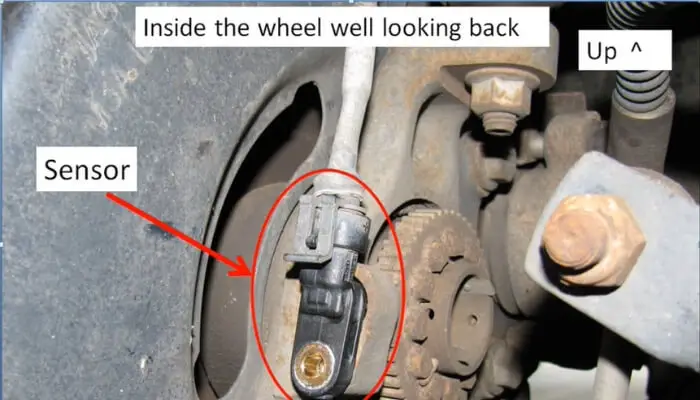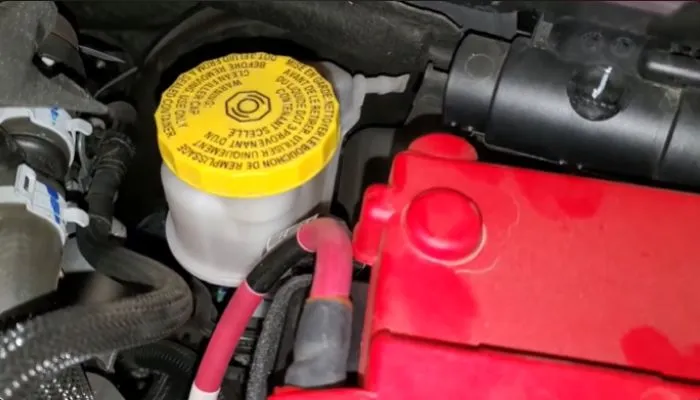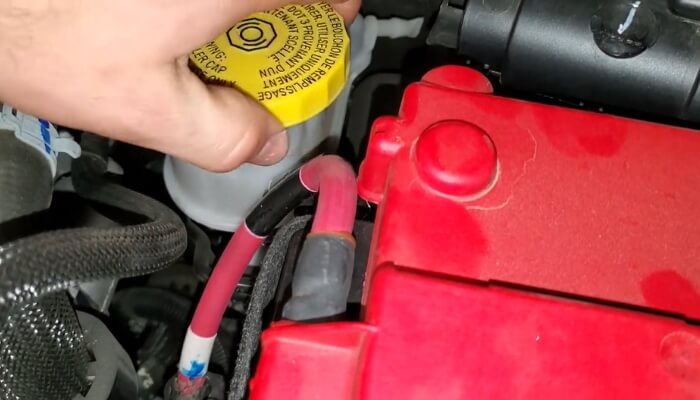If the ABS and traction control lights are on in your Jeep Patriot, it generally indicates a problem with the vehicle’s anti-lock brake system or traction control system. This could be due to issues such as a faulty wheel speed sensor, damaged wiring, or a malfunctioning control module.
It’s crucial to have the vehicle diagnosed by a qualified mechanic to pinpoint the specific cause and address the problem effectively. Ignoring these warning lights can compromise the vehicle’s safety and performance.
We will discuss potential causes and solutions for the ABS and traction control lights being illuminated in your Jeep Patriot, helping you better understand and address the issue.

What Does the ABS System Do?
The ABS system is a crucial safety feature in modern vehicles, including Jeeps. It prevents the wheels from locking up during sudden or hard braking, allowing the driver to maintain steering control and avoid skidding. Here are some key reasons why the ABS is essential in a Jeep:

1. Improved Braking Performance
The ABS system significantly enhances the braking performance of a Jeep. Preventing wheel lock-up ensures that the tires maintain contact with the road surface, allowing the vehicle to stop more effectively and at a shorter distance.
2. Enhanced Stability and Control
During emergency braking situations or when driving on slippery or uneven surfaces, the ABS system helps maintain the stability and control of the Jeep. It prevents skidding and fishtailing, making it easier for the driver to navigate through challenging road conditions.
3. Avoidance of Accidents
Jeep drivers often encounter off-road terrains and adverse weather conditions. The ABS system reduces the risk of accidents by preventing wheel lock-up and helping the driver maintain vehicle control in critical situations.
4. Steerability During Braking
One of the most significant advantages of ABS is that it allows the driver to steer the vehicle while braking. This capability is crucial for avoiding obstacles or hazards on the road, further improving the driver’s and passengers’ safety.
5. All-Terrain Safety
Jeeps are renowned for their off-road capabilities and are often used in rugged terrains and challenging environments. The ABS system ensures the Jeep can handle various surfaces without compromising safety.
6. Reduces Wear and Tear
Due to wheel lock-up, traditional braking systems without ABS can cause excessive wear on tires and other braking components. The ABS system helps prevent such wear and tear, thus extending the lifespan of braking components.
7. Safety in Wet Conditions
When driving on wet roads, there is an increased risk of skidding and losing control during braking. The ABS system minimizes these risks by modulating the brake pressure on each wheel, and maintaining traction and control.
8. Driver Confidence
Knowing that their vehicle is equipped with ABS, Jeep drivers can have increased confidence in handling emergencies and difficult road conditions. This confidence can lead to safer driving practices overall.
Abs And Traction Control Indicators
When driving your Jeep Patriot, it’s crucial to be aware of the indicators for ABS and traction control, as they are integral to your vehicle’s safety features. Identifying these warning lights can help you address potential issues promptly, ensuring a smooth and safe driving experience. Let’s delve into the specifics of these indicators and how to interpret them.
Abs Light Symbol
The ABS (Anti-lock Braking System) light symbol is designed to alert you to potential issues with the vehicle’s braking system. When illuminated, it indicates a fault or malfunction in the ABS system. This warning light serves as a reminder to have the system inspected by a qualified technician to ensure the continued effectiveness of your vehicle’s braking mechanism.
Traction Control Light Symbol
The traction control light symbol, also known as TCS (Traction Control System) light, signifies a potential issue with the vehicle’s traction control system. This light usually comes on when there is a loss of traction, indicating that the system is actively working to regain traction.
However, if the light remains illuminated, it may indicate a fault in the system that requires professional attention.
Combined Illumination
When both the ABS and traction control light symbols illuminate simultaneously, it could indicate a related issue in the vehicle’s stability control system. It is vital to address combined illumination promptly to ensure the overall safety and performance of your vehicle.
Common Triggers For Dashboard Alerts
When driving, seeing the ABS and Traction Control warning lights illuminate on your Jeep Patriot dashboard can be concerning. Several factors can trigger these alerts, and identifying the root cause is crucial for maintaining the safety and performance of your vehicle.

Credit: www.jeeppatriot.com
Wheel Speed Sensors
One of the most prevalent triggers for the ABS and Traction Control lights is malfunctioning wheel speed sensors. These sensors are responsible for detecting the speed of each wheel and relaying this information to the ABS and Traction Control systems.
If a sensor fails or sends inaccurate data, it can cause these critical safety features to disengage, prompting the warning lights to activate.

Brake Fluid Levels
Insufficient brake fluid levels can also lead to the illumination of the ABS and Traction Control lights. As the primary hydraulic fluid for the braking system, low brake fluid levels can impede the proper functioning of the ABS components, triggering the warning indicators on the dashboard. Monitoring and maintaining adequate brake fluid levels is vital to prevent potential issues with these systems.
Faulty Abs Module
A faulty ABS module can contribute to the activation of the ABS and Traction Control warning lights. The ABS module, integral to the functioning of these systems, can experience malfunctions or electronic failures, leading to the illumination of the dashboard alerts.
Symptoms such as pulsating brakes or unusual noises during braking may also accompany this issue, signalling the need for further inspection and potential module replacement.
Glitches And Electrical Issues
Temporary glitches and electrical issues within the ABS and Traction Control systems can intermittently trigger the dashboard alerts.
Whether due to wiring issues, sensor connectivity problems, or electrical interruptions, these transient issues can cause the warning lights to illuminate sporadically. Thorough diagnostics are essential to pinpoint and address such underlying electrical concerns.

Credit: m.youtube.com
Steps To Determine The Root Cause
When the ABS and Traction Control Light in your Jeep Patriot illuminate, it’s crucial to identify the root cause before proceeding with any repairs. This not only saves time and money but also ensures a precise and effective solution to the issue. Below are the essential steps to determine the underlying problem causing the ABS and Traction Control Light to turn on.
Professional Diagnostic Scan
A professional diagnostic scan is of utmost importance when dealing with ABS and traction control issues in your Jeep Patriot. The scan provides vital data on the status of various vehicle systems, highlighting any potential malfunctions.
Trained technicians use specialized tools to perform a thorough diagnostic scan, enabling them to pinpoint the specific areas requiring attention.
Preliminary Visual Check
Before delving into complex diagnostics, a preliminary visual check can offer valuable insights. This involves visually inspecting the ABS and traction control components for any obvious signs of damage, such as loose connections, worn wires, or fluid leaks. While this step may not uncover all issues, it can provide a starting point for further investigation.
Understanding Error Codes
When the ABS and Traction Control Light illuminate, the vehicle’s onboard diagnostic system generates error codes to indicate the specific issues triggering the warning lights. Understanding these error codes and their meanings is crucial in diagnosing the root cause.
Each code corresponds to a particular problem, empowering technicians to identify the exact nature of the issue and formulate an effective repair strategy.
What to do If Jeep Patriot ABS Light Comes On?
While it’s essential to have the Jeep Patriot ABS issue fixed by a professional mechanic, there are some temporary measures you can take if you find yourself in a situation where the ABS light comes on during your journey.
Stay Calm
Don’t panic. An illuminated ABS light doesn’t mean your brakes have completely failed, but it does indicate an issue that needs attention.
Check Brake Fluid Level

Verify the brake fluid level in the reservoir. If it’s low, top it up to the recommended level and check for any visible leaks.
Inspect Brake Components
Visually inspect your brake pads and rotors for signs of wear or damage. If they appear worn out, it’s crucial to get them replaced.
Clearing Wheel Speed Sensor Obstructions
Ensure the wheel speed sensors are clean and free from debris or dirt that might hinder their functionality.
Checking ABS Fuse
Verify the condition of the ABS fuse and replace it if it’s blown.
Avoid Aggressive Driving
Driving cautiously until the problem is resolved and avoid aggressive braking, especially on wet or slippery roads.
Keep an Eye on Other Warning Lights
If multiple warning lights come on along with the ABS light, it could indicate a more severe problem, and you should refrain from driving the vehicle until it is inspected.
Seeking Professional Assistance
While temporary solutions may provide a quick fix, it’s crucial to seek the expertise of a qualified mechanic to diagnose and repair the ABS system properly. Only a trained professional can accurately identify the root cause of the problem and ensure that your Jeep’s ABS is functioning optimally.
Addressing Jeep Patriot Abs And Traction Control Light On
If you’re seeing the ABS and traction control light illuminate on your Jeep Patriot’s dashboard, it’s essential to address the issue promptly to ensure the safety and performance of your vehicle.
The ABS (anti-lock braking system) and traction control systems are crucial for maintaining control in various driving conditions, and when the warning lights appear, it’s a sign that there may be an issue that needs attention.
Diy Fixes Vs. Professional Repair Services
When facing the ABS and traction control light on your Jeep Patriot, you may wonder whether you should attempt DIY fixes or seek professional repair services. While some basic troubleshooting and maintenance tasks can be done at home, certain complex issues may require the expertise of a professional mechanic.
It’s important to assess the severity of the problem and your own mechanical skills before deciding whether to tackle the repairs yourself or seek professional help.
Estimated Costs For Common Repairs
Addressing the ABS and traction control light on your Jeep Patriot may involve various repairs, each with its associated costs. From sensor replacement to brake system maintenance, understanding the estimated costs for common repairs can help you budget effectively and make informed decisions when seeking professional assistance.
By being aware of the potential expenses, you can plan for the necessary repairs and ensure the optimal functioning of your vehicle’s ABS and traction control systems.
Maintenance Tips
Proper maintenance is key to preventing issues related to the ABS and traction control systems in your Jeep Patriot. Regular inspections, timely fluid changes, and ensuring proper sensor functionality are essential for maintaining the optimal performance of these critical safety features.
By following specific maintenance tips and staying proactive, you can enhance the longevity and reliability of your ABS and traction control systems, contributing to a safe and smooth driving experience.
Optimal Functioning Of Safety Features

Credit: www.reddit.com
As a proud owner of a Jeep Patriot, ensuring the optimal functioning of its safety features is essential for a smooth and secure driving experience. Two crucial safety indicators that demand attention are the ABS and Traction Control warning lights on the dashboard.
Maintenance Schedule
Following the recommended maintenance schedule for your Jeep Patriot is vital to ensure the proper functioning of the ABS and traction control systems. Consistent maintenance checks at the intervals specified by the manufacturer will help in identifying and addressing any issues before they escalate.
Dashboard Warnings
Immediate attention should be given to the dashboard warnings related to the ABS and Traction Control lights. Ignoring these warnings can lead to a compromised braking system and reduced stability control.
Addressing these issues promptly is essential for ensuring the safety of both the driver and passengers. Intervening early can also prevent more significant problems from arising, ultimately saving on repair costs.
Relationship Between Tire Condition And Traction Control Systems
The condition of the tires directly impacts the functioning of the traction control system. It is crucial to maintain adequate tire pressure and tread depth to allow the system to operate effectively. Incorrect tire pressure and worn-out treads can diminish the system’s ability to maintain grip, leading to increased risk of skidding and loss of control in hazardous driving conditions.
Jeep Patriot Abs 4Wd And Traction Control Light on
If you have a Jeep Patriot with ABS and the 4WD light is on, there is a good chance that the traction control system is also not working. This can be a serious safety issue, so it’s important to understand what might be causing the problem and how to fix it. There are a few potential causes for this issue:
1. A fuse may have blown. Check the fuse box and replace any blown fuses.
2. There could be an issue with the ABS sensor. This can often be resolved by cleaning the sensor or replacing it if necessary.
3. The ABS pump may need to be replaced. This is a more serious repair, but it may be necessary if other solutions don’t work.
4. Finally, it’s possible that there is an issue with the actual traction control system itself. This will likely require professional diagnosis and repair.
How to Reset Abs Light on Jeep Patriot
If your Jeep Patriot’s ABS light is on, it means there is a problem with the anti-lock braking system. You will need to find and fix the underlying issue to reset the light.
First, check all the ABS sensors and wiring for any damage or loose connections.
If everything looks good there, then the next step is to bleed the brakes. This will get rid of any air bubbles that may be in the system and cause the light to come on. Once you have bled the brakes, take your Jeep Patriot out for a test drive.
If the ABS light is still on, there may be an issue with one of the sensors or the control module itself. In this case, it will need to be diagnosed by a professional.
2016 Jeep Patriot Abs 4Wd And Traction Control Light on
If you’re driving a Jeep Patriot and you see the ABS 4WD and Traction Control Light on, there’s definitely something wrong. Here’s what you need to know about this situation.
First, it’s important to understand that the ABS system is designed to help keep your vehicle stable when braking on slippery or uneven surfaces. When the light comes on, it means that there’s an issue with this system.
There are a few different things that can cause the light to come on, but usually it indicates that there’s a problem with one of the sensors or components in the system. In some cases, it could just be a loose wire or connection.
But if the light stays on, it’s definitely time to get your Jeep checked out by a professional. Once you take your Jeep in for service, they can diagnose the problem and let you know what needs to be done to fix it. In most cases, getting everything back up and running properly shouldn’t be too difficult or expensive.
So if you see the ABS 4WD and Traction Control Light on in your Jeep Patriot, don’t ignore it! Bring your vehicle in for servicing as soon as possible to avoid any potential accidents down the road.
2011 Jeep Patriot Abs Light And Traction Control
If your Jeep Patriot is equipped with ABS, the ABS light will come on when you start your vehicle and should go off after a few seconds. If the light remains on, it indicates a problem with the system.
The most common reason for the ABS light to come on is a faulty sensor. If your Jeep Patriot is also equipped with traction control, you may notice that the traction control light comes on along with the ABS light.
This is because both systems share sensors; if one sensor is not working correctly, it can affect both systems. If either of these lights comes on, it’s important to have your vehicle checked out by a qualified mechanic as soon as possible to avoid any further damage.
Abs And Traction Control Light on 2016 Jeep Patriot
If you have the abs and traction control light on in your 2016 Jeep Patriot, it may be time to take it into the dealership for a check. A few things could be causing this problem, so it’s best to let the professionals take a look.
It could be something as simple as a loose wire or connection or something more serious like a problem with the ABS system itself. Either way, getting it checked out is the best course of action.
Why is My Abs And Traction Control Light on Jeep Patriot?
If you have a Jeep Patriot, and the ABS and traction control light is on, there are a few things that could be causing it.
- The first thing to check is the brake fluid level – if it’s low, then topping it up should fix the problem.
- If the fluid level is fine, then it’s likely that one of the sensors in the system has failed.
This will need to be diagnosed and repaired by a qualified mechanic.
What Does It Mean When Your Abs And Traction Control Light Comes On?
If you’re driving and your Jeep ABS and traction control light comes on, it means there’s a problem with one of the sensors in your anti-lock braking system or traction control system.
This can be caused by a faulty sensor, a loose wire, or something else entirely. In any case, it’s important to get the problem diagnosed and fixed as soon as possible, as it could lead to more serious issues down the road.
Can I Drive My Car With Abs And Traction Control Light On?
It’s never a good idea to drive with either the ABS or traction control light on. Both of these systems are important for maintaining traction and stability while driving, and if either one is not functioning properly, it can lead to some serious problems.
If your ABS light is on, there is a problem with the system and it needs to be checked out as soon as possible. Driving without ABS can be extremely dangerous, especially in slippery or icy conditions.
Traction control is also an important safety feature, and if that light is on, there may be a problem with the system. Again, it’s best to have this checked out by a professional before driving any further.
How Do I Clear My Abs And Traction Control Light?
If your ABS or traction control light is on, it means that there is an issue with one of the sensors or systems in your vehicle. In order to clear the light, you will need to have the problem diagnosed and repaired by a mechanic. ABS stands for anti-lock braking system.
This system prevents your wheels from locking up when you brake hard. The ABS sensor monitors the speed of each wheel and sends a signal to the computer when one of them is about to lock up. The computer then adjusts the braking pressure to prevent the wheel from locking up.
Traction control helps you maintain traction while driving on slippery surfaces. It does this by reducing engine power and applying brakes to individual wheels when it detects that one of them is losing traction.
Like ABS, traction control uses sensors to monitor wheel speed and can cause the check engine light to come on if there is a problem with one of the sensors or systems.
Wrapping Up
Addressing the ABS and traction control light issues in your Jeep Patriot is crucial for safe and efficient driving. Regular maintenance and timely diagnostics are essential in resolving these warning signals. By taking proactive steps to address these concerns, you can ensure the optimal performance and longevity of your vehicle.
FAQs
Why Are The Abs And Traction Control Lights On In My Jeep Patriot?
The ABS and Traction Control lights may come on due to a faulty wheel speed sensor, a damaged ABS ring, or low brake fluid levels. It’s crucial to have your vehicle checked by a professional to diagnose and address the issue promptly.
How Can I Troubleshoot The Abs And Traction Control Lights In My Jeep Patriot?
Start by checking the brake fluid levels, then inspect the wheel speed sensors for damage or debris. If the issue persists, consult a qualified mechanic to conduct a thorough diagnostic and resolve any underlying problems effectively.
What Are The Potential Risks Of Driving With The Abs And Traction Control Lights On?
Driving with these warning lights illuminated can compromise your vehicle’s stability and braking performance, especially in adverse road conditions. It is essential to address the issue promptly to ensure your safety and the proper functioning of your vehicle’s braking system.
How Much Does It Cost To Fix The Abs And Traction Control Lights On A Jeep Patriot?
The cost of fixing the ABS and Traction Control lights on a Jeep Patriot can vary depending on the specific issue and the labor rates in your location. Generally, repairs can range from $100 to $1000. It is recommended to consult a professional mechanic who can provide a more accurate estimate after assessing the problem.
What Are Some Common Causes Of Abs And Traction Control Issues In A Jeep Patriot?
Common causes of ABS and Traction Control issues in a Jeep Patriot include faulty wheel speed sensors, damaged ABS control module, ABS pump motor failure, wiring issues, or a low brake fluid level. It is advisable to have your vehicle diagnosed by a qualified technician to pinpoint the exact cause and address it effectively.

